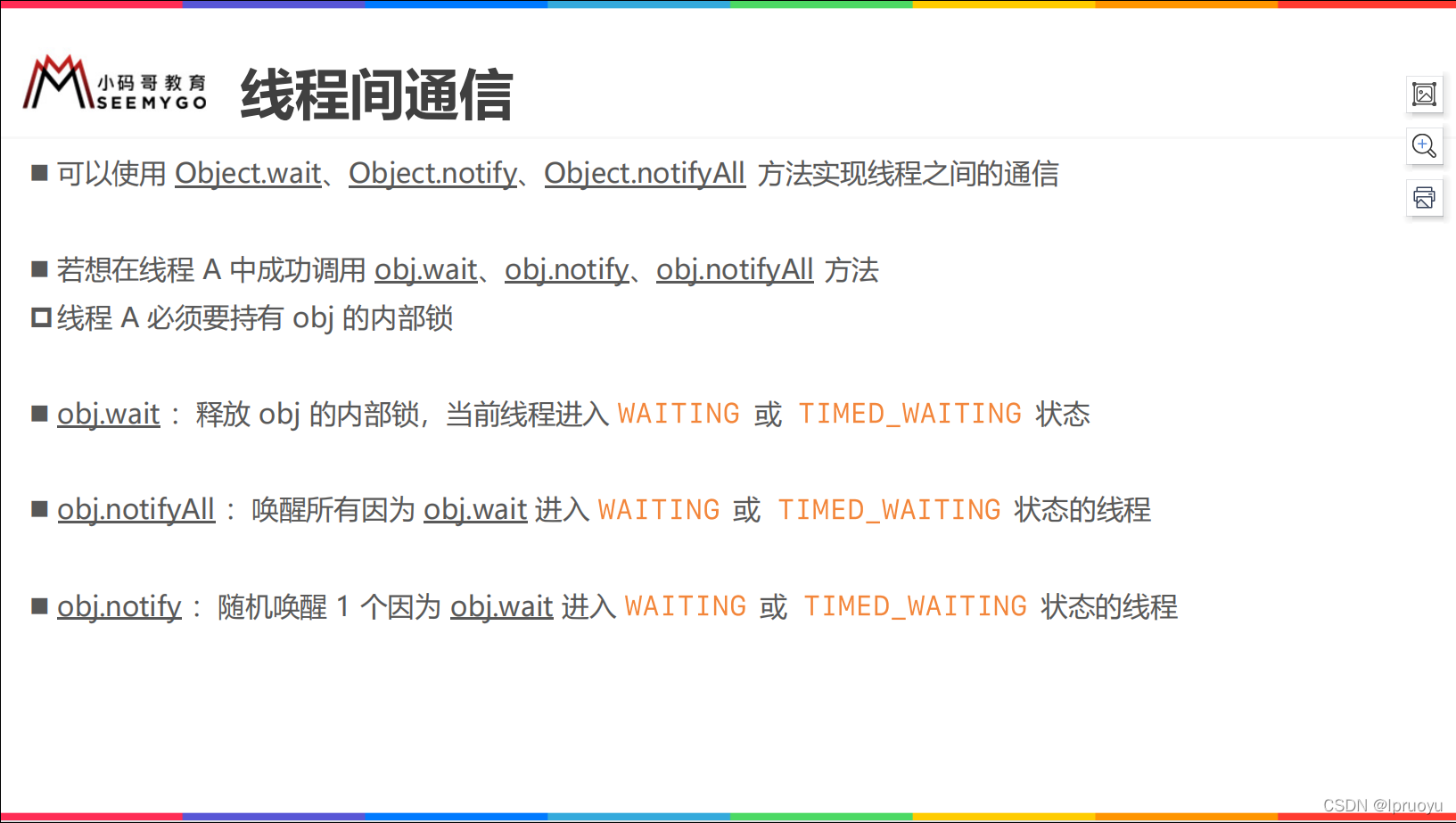持续学习&持续更新中…
守破离
【Java从零到架构师第1季】【并发 Concurrent 03】线程间通信_ReentrantLock_线程池
线程间通信
- 调用wait、notify、notifyAll方法的obj对象必须是同一个
- 调用wait、notify、notifyAll方法的线程必须拥有该obj对象的内部锁

线程间通信—示例



注意:
-
消费者线程和生产者线程中调用obj.wait、obj.notify、obj.notifyAll方法时,使用的obj必须是同一个对象。
-
消费者线程和生产者线程必须持有obj的内部锁(监视锁),才能成功调用wait、notify、notifyAll方法,否则会出现异常。
代码:
Producer:
public class Producer implements Runnable{
private Drop drop;
public Producer(Drop drop) {
this.drop = drop;
}
@Override
public void run() {
String[] foods = {"beef", "bread", "apple", "cookie", "banana"};
for (String food : foods) {
try {
Thread.sleep(1500);
} catch (InterruptedException e) {}
drop.add(food);
}
drop.add(null);
}
}
Consumer:
public class Consumer implements Runnable {
private Drop drop;
public Consumer(Drop drop) {
this.drop = drop;
}
@Override
public void run() {
String food;
while ((food = drop.get()) != null) {
// try {
// Thread.sleep(1500);
// } catch (InterruptedException e) {}
System.out.println("消费了:" + food);
}
}
}
Drop:
version1:
public class Drop {
private String food;
// isEmpty:true:消费者需要等待生产者
// isEmpty:false:生产者需要等待消费者
private boolean isEmpty = true;
public synchronized void add(String food) {
if(isEmpty) { // 如果没有food
this.food = food; // 直接生产food
isEmpty = false; // 生产了food之后,就不为空了
notifyAll(); // 生产好food后,就可以通知消费者线程消费food了
}else { // 如果food还有,还没有被消费者消费完毕
try { // 等待消费者消费完毕food
wait();
} catch (InterruptedException e) {}
this.food = food; // 消费者消费完food后,就可以生产food了
isEmpty = false; // 生产了food之后,就不为空了
notifyAll(); // 就可以通知消费者线程消费food了
}
}
public synchronized String get() {
if(isEmpty) { // 如果此时没有food,也就是生产者线程还没有生产完毕food
try { // 等待生产者生产food
wait();
} catch (InterruptedException e) {}
} // 当生产者生产好了food之后,就可以消费food了
// 此时有food可以消费
isEmpty = true; // 消费了food,那么就应该为空了
notifyAll(); // 通知生产者线程,我已经消费了food,你可以继续生产food了
return food;
}
}
老师课件上写的
while(empty)是为了防止wait时出现异常(如果wait时出现了异常并且不做任何处理的话,那么程序就会按顺序执行下去,那样的话程序就会出现bug;因此使用while循环:如果wait时出现了异常还会继续wait)
在wait时应该使用while循环来防止wait失败(如果wait出现异常,还得继续wait)
version2(使用while循环代替if循环):
public class Drop {
private String food;
// isEmpty:true:消费者需要等待生产者
// isEmpty:false:生产者需要等待消费者
private boolean isEmpty = true;
// 使用while循环代替if循环、使用while循环执行wait方法的目的是:
// 当wait时出现异常,还会继续wait,而不是执行之后的代码
public synchronized void add(String food) {
if(isEmpty) { // 如果没有food
this.food = food; // 直接生产food
isEmpty = false; // 生产了food之后,就不为空了
notifyAll(); // 生产好food后,就可以通知消费者线程消费food了
}else { // 如果food还有,还没有被消费者消费完毕
while(!isEmpty) {
try { // 等待消费者消费完毕food
wait();
} catch (InterruptedException e) {}
}
this.food = food; // 消费者消费完food后,就可以生产food了
isEmpty = false; // 生产了food之后,就不为空了
notifyAll(); // 就可以通知消费者线程消费food了
}
}
public synchronized String get() {
while(isEmpty) { // 如果此时没有food,也就是生产者线程还没有生产完毕food
try { // 等待生产者生产food
wait();
} catch (InterruptedException e) {}
} // 当生产者生产好了food之后,就可以消费food了
// 此时有food可以消费
isEmpty = true; // 消费了food,那么就应该为空了
notifyAll(); // 通知生产者线程,我已经消费了food,你可以继续生产food了
return food;
}
}
测试:
public static void main(String[] args) {
/*
1.调用wait、notify、notifyAll方法的obj对象必须是同一个
2.调用wait、notify、notifyAll方法的线程必须拥有该obj对象的内部锁
*/
Drop drop = new Drop();
Consumer consumer = new Consumer(drop);
Producer producer = new Producer(drop);
new Thread(consumer).start();
new Thread(producer).start();
}
可重入锁ReentrantLock

public static void main(String[] args) {
// 可重入锁,有些地方叫做递归锁
// synchronized是可重入的
synchronized ("1") {
synchronized ("1") {
System.out.println("1");
}
}
}
我们可以认为:每一个线程都有属于自己的锁持有计数器



ReentrantLock的使用

public class Station implements Runnable {
private final ReentrantLock lock = new ReentrantLock();
private int tickets = 100;
public boolean saleTicket() {
try{
lock.lock();
if (tickets < 1) return false;
tickets--;
System.out.println(Thread.currentThread().getName() + "卖了一张票,还剩" + tickets + "张票。");
return tickets > 0;
}finally {
lock.unlock();
}
}
@Override
public void run() {
while (saleTicket()) ;
}
}

线程池

线程池—基本使用

public static void main(String[] args) {
final ExecutorService pool = Executors.newFixedThreadPool(5);
for (int i = 1; i <= 10; i++) {
pool.execute(() -> {
System.out.println(Thread.currentThread().getName());
});
}
pool.shutdown();
}
参考
小码哥-李明杰: Java从0到架构师①零基础高效率入门.
本文完,感谢您的关注支持!